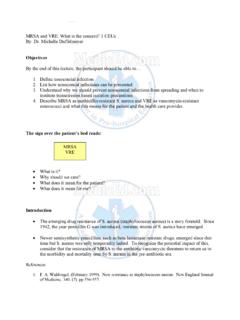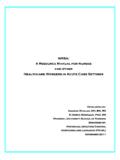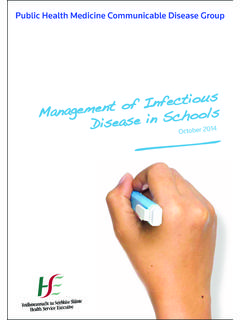Transcription of The Next MRSA - - RN.org®
1 The next MRSA Reviewed June, 2016, Expires June, 2018 Provider Information and Specifics available on our Website Unauthorized Distribution Prohibited 2016 , , , LLC By Melissa Slate, RN, MS Objectives By the end of this educational module, the learner will be able to: Recognize at risk populations for Acinetobacter infections Verbalize methods by which Acinetobacter is spread Verbalize methods to control the spread of Acinetobacter Opening A nurse at Bethesda Medical center leaves works feeling unwell.
2 Within 24 hours she is hospitalized and on a respirator, her diagnosis: Acinetobacter. It was determined that she acquired the infection from a patient. She quickly dies from the illness, and little attention is paid to it. An outbreak of Multi-Drug Resistant Acinetobacter struck in Arizona with 236 cases logged in just 2 months. Reported at the state level, the outbreak was again ignored at the national level. As early as 2003, American soldiers in Iraq were testing positive for Acinetobacter baumanni at Walter Reed Medical Center, Landstuhl, and the hospital ship Comfort.
3 Most of the amputations from the war are not coming from the trauma, but the subsequent infection that follows. If they are lucky, an amputation is the best-case scenario, if they are unlucky they wind up with kidney failure, or death. The bacteria is now infecting civilian hospitals as some soldiers return as unsuspecting carriers of the bacteria, with no symptoms of illness, but the ability to pass the pathogen on to others. Again, little is said by the military or the government to warn them about this potentially deadly bacterium that many are already calling the next MRSA.
4 Medical scientists who are watching the problem fear that the outbreaks could become pandemic. The bacterium is rapidly making its way into hospitals in all parts of the globe. The bacterium is highly resistant to almost all antibiotics, and its characteristics make it difficult to eradicate. Some facilities have had to shut down whole units for terminal cleaning to curtail outbreaks. Literature has documented the mortality rate for infection from AB to be as high as 70% in some areas (Cisneros, , 1996).
5 Medical science is no stranger to multi-drug resistant bacteria. The problem of both hospital acquired and community acquired MRSA is common in the news. C diff is endemic in ever increasing numbers. The problem isn t going to go away, and the antibiotics are not able to fight it. What options are left? Identification Acinetobacter family comprises 17 named and 14 unnamed species. Identification of the organism down to the species level is difficult in a normal microbiology lab. Specific species isolation is often done by genetic fingerprinting of the bacteria by DNA or RNA technology.
6 For this reason, the acinetobacter are usually grouped into three categories: Acinetobacter calcoaceticus-baumanii complex: glucose-oxidising nonhemolytic, ( can be identified by OXA-51 typing) This is the species most relative to our discussion. Acinetobacter lwoffii: glucose-negative nonhemolytic Acinetobacter haemolyticus: hemolytic (Wikipedia) Characteristics Acinetobacter baumannii (AB) is a pathogenic, opportunistic infection which has been recently receiving gaining attendion due to its ability to cause significant complications and increased mortality in hospitalized individuals and in a few cases has caused death in apparently healthy persons.
7 Another worry among scientists and health care professionals is the emergence of multi-drug resistence amoung the AB species. These multi-resistant strains are often referred to as MDRAB. MDRAB is the most revalent pathogen within the acinetobacter family. One interesting feature of the AB pathogen is its ability to receive and donate genetic material from other pathogens, which quickly leads to the replication of more MDRAB and other drug resistant pathogens. Acinetobacter is Greek for the word motionless, and they have no means of self motility.
8 AB can survive independently in the environment under dry conditions for times varying between 6 to 25 days (Wendt, , 1997). It has also been found to live in warm, moist environments such as wound irrigation devices and respirator tubing. AB is a gram negative aerobic non-fermantative baccili. AB can exhibit quite variable characteristics upon Gram staining, so it is an unreliable testing measure for the organism. AB is found in several different sources, soil, water, sewage, some food items, medical equipment, and even healthy human skin Occurrence Acinetobacter baumannii is currently the third most common organism isolated in septic patients who are immunocompromised (Joshi, 2006).
9 In Israel, where MDRAB has reached epidemic proportions, it is the first or second most common cause of sepsis in the ICU s. Once established, it is very difficult to control, Israel has been successful in using strict infection control measures to control MRSA, however they have made no difference with MDRAB. Complicating matters even further is that MDRAB tends to be polyclonal; in other words, you have multiple variants of the same strain, making it harder to eliminate (Wachter, 2006). MDRAB has infected hundreds of soldiers in the Iraq war, causing more loss of life and limbs than the original injuries themselves.
10 At first, it was though that the organism was present in the soil, but soil samples tested negative. Further investigation revealed that the organism was rampant in field hospitals in which the soldiers were receiving treatment, making it a noscomial infection. In the last 10 years, the occurrence of MDRAB has almost quadrupled (ASM). The infection is most frequently found in patients 19-64 years of age and is more frequently found in larger hospitals than in smaller ones, however MDRAB has been found in all types of patients and care settings.
















